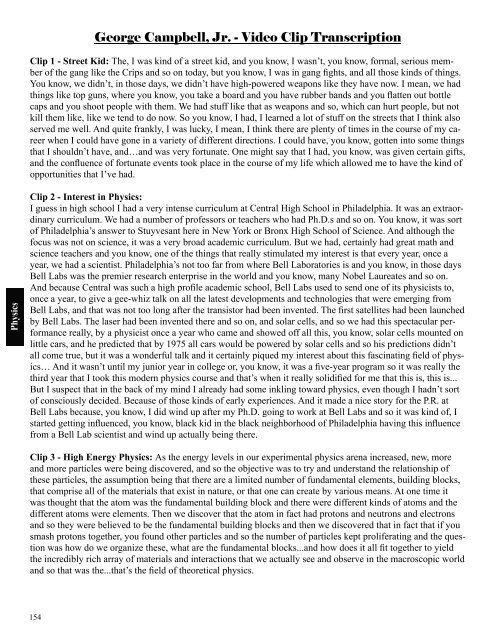ScienceMakers Toolkit Manual - The History Makers
ScienceMakers Toolkit Manual - The History Makers
ScienceMakers Toolkit Manual - The History Makers
You also want an ePaper? Increase the reach of your titles
YUMPU automatically turns print PDFs into web optimized ePapers that Google loves.
Physics<br />
154<br />
George Campbell, Jr. - Video Clip Transcription<br />
Clip 1 - Street Kid: <strong>The</strong>, I was kind of a street kid, and you know, I wasn’t, you know, formal, serious member<br />
of the gang like the Crips and so on today, but you know, I was in gang fi ghts, and all those kinds of things.<br />
You know, we didn’t, in those days, we didn’t have high-powered weapons like they have now. I mean, we had<br />
things like top guns, where you know, you take a board and you have rubber bands and you fl atten out bottle<br />
caps and you shoot people with them. We had stuff like that as weapons and so, which can hurt people, but not<br />
kill them like, like we tend to do now. So you know, I had, I learned a lot of stuff on the streets that I think also<br />
served me well. And quite frankly, I was lucky, I mean, I think there are plenty of times in the course of my career<br />
when I could have gone in a variety of different directions. I could have, you know, gotten into some things<br />
that I shouldn’t have, and…and was very fortunate. One might say that I had, you know, was given certain gifts,<br />
and the confl uence of fortunate events took place in the course of my life which allowed me to have the kind of<br />
opportunities that I’ve had.<br />
Clip 2 - Interest in Physics:<br />
I guess in high school I had a very intense curriculum at Central High School in Philadelphia. It was an extraordinary<br />
curriculum. We had a number of professors or teachers who had Ph.D.s and so on. You know, it was sort<br />
of Philadelphia’s answer to Stuyvesant here in New York or Bronx High School of Science. And although the<br />
focus was not on science, it was a very broad academic curriculum. But we had, certainly had great math and<br />
science teachers and you know, one of the things that really stimulated my interest is that every year, once a<br />
year, we had a scientist. Philadelphia’s not too far from where Bell Laboratories is and you know, in those days<br />
Bell Labs was the premier research enterprise in the world and you know, many Nobel Laureates and so on.<br />
And because Central was such a high profi le academic school, Bell Labs used to send one of its physicists to,<br />
once a year, to give a gee-whiz talk on all the latest developments and technologies that were emerging from<br />
Bell Labs, and that was not too long after the transistor had been invented. <strong>The</strong> fi rst satellites had been launched<br />
by Bell Labs. <strong>The</strong> laser had been invented there and so on, and solar cells, and so we had this spectacular performance<br />
really, by a physicist once a year who came and showed off all this, you know, solar cells mounted on<br />
little cars, and he predicted that by 1975 all cars would be powered by solar cells and so his predictions didn’t<br />
all come true, but it was a wonderful talk and it certainly piqued my interest about this fascinating fi eld of physics…<br />
And it wasn’t until my junior year in college or, you know, it was a fi ve-year program so it was really the<br />
third year that I took this modern physics course and that’s when it really solidifi ed for me that this is, this is...<br />
But I suspect that in the back of my mind I already had some inkling toward physics, even though I hadn’t sort<br />
of consciously decided. Because of those kinds of early experiences. And it made a nice story for the P.R. at<br />
Bell Labs because, you know, I did wind up after my Ph.D. going to work at Bell Labs and so it was kind of, I<br />
started getting infl uenced, you know, black kid in the black neighborhood of Philadelphia having this infl uence<br />
from a Bell Lab scientist and wind up actually being there.<br />
Clip 3 - High Energy Physics: As the energy levels in our experimental physics arena increased, new, more<br />
and more particles were being discovered, and so the objective was to try and understand the relationship of<br />
these particles, the assumption being that there are a limited number of fundamental elements, building blocks,<br />
that comprise all of the materials that exist in nature, or that one can create by various means. At one time it<br />
was thought that the atom was the fundamental building block and there were different kinds of atoms and the<br />
different atoms were elements. <strong>The</strong>n we discover that the atom in fact had protons and neutrons and electrons<br />
and so they were believed to be the fundamental building blocks and then we discovered that in fact that if you<br />
smash protons together, you found other particles and so the number of particles kept proliferating and the question<br />
was how do we organize these, what are the fundamental blocks...and how does it all fi t together to yield<br />
the incredibly rich array of materials and interactions that we actually see and observe in the macroscopic world<br />
and so that was the...that’s the fi eld of theoretical physics.










